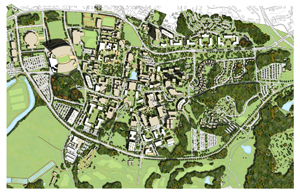|
||||||
|
Vision that directs institutional growth and change is an elusive but critical component for campus planning. Arthur discusses the importance of developing a simple, forceful guiding statement that can be implemented through clear goals delegated to the appropriate people and offices. George offers some suggestions for maintaining momentum in plan implementation, even when tight budgets constrain large-scale efforts. A combination of wisdom and persistence will advance many goals that strengthen institutional position as the economy improves.
If you have reactions or ideas to share, please let us know what you think by e-mailing: editor@dlmplanners.com |
||||||
|
It is not often that a quote from the Old Testament can be found in a piece about campus planning. Having an institutional vision is one of the most important first steps of a campus planning process. Yet, often it is either missing entirely or done so poorly that it squanders its impact. Most vision statements are less about defining a future, than describing the present. They are more a mission statement that describes what the institution is presently doing than a statement of what the institution intends to become. Most vision statements are so generic that they are interchangeable – just swap the name of your college or university with some other institution’s vision statement and see if it applies. Words such as “we will become ..,” or “we aspire to be ..,” or “we will be ..,” are indicative of a vision statement that is describing a future state. Jim Barker, the President of Clemson University in South Carolina had a simple but very effective vision: “Clemson will be one of the Nation’s top-20 public universities.” That vision has helped to transform the University. A vision statement is worthless, if there isn’t a plan to achieve it. For instance, Clemson’s vision was accompanied by 27 goals that were divided into five categories: academics, research and service; campus life; student performance; educational resources; and Clemson’s national reputation. Responsibility for realizing the goals was assigned to actual people or the offices they held. Both vision and goals were approved by the Board.
Shirley Ann Jackson, the President of Rensselaer Polytechnic Institute, developed another example of a simple, but effective vision: “To achieve greater prominence in the 21st century as a top-tier world-class technological research university with global reach and global impact.” RPI developed 150 goals to support this vision and these goals fit into six themes: resident undergraduate education; research and graduate education; education for working professionals; scientific and technological entrepreneurship; Rensselaer communities; and enabling change. Again, key leaders were charged with achieving goals. Both vision and goals were approved by the Board. The results of Dr. Jackson’s simple vision are:
The lack of an institutional vision is a failure of leadership – because it is the responsibility of the president or the executive cabinet to create a sense of direction toward a future and a detailed, strategy and accountable plan for achieving that vision. “The planning effectiveness of a campus depends on the planning effectiveness of its presidential leadership. There is no escape from this situation." John Millett “You got to be careful if you don't know where you're going, because you might not get there.” Yogi Berra
Arthur Lidsky |
|||||||
|
|
||||
The past year has been a real wet blanket on the fire that has burned merrily over the past decade driving the engine of campus development. A year in which the key campus development questions have abruptly morphed from “How can we secure that final lead donation for our new facility?” to “How many more people are going to be furloughed or laid off?” As Arthur wrote back in Issue 21, down economies can be excellent periods in which to advance transformative strategic planning. In the physical and project planning realm, however, many participants are likely to be asking, “What’s the point in planning a new facility or renovation that there’s no money to build?” But just as this can be a good time for big picture plans, it’s also a good time for pre-architectural project planning. A couple of ideas:
Take advantage of this time to establish visions and guidelines that can be applied to the next wave of projects you anticipate as the economy improves and feasibility returns.
George Mathey
|
||||
NEWS |
||||||
New Projects
Completed Projects
|
On a Personal Note She is also helping to organize the Aquidneck Land Trust's second annual Race For Open Space, a 5K race for runners and walkers that takes place on the conserved Sakonnet Greenway Trail on Saturday, November 7th. Meet Petey
|
|||||
|
||||||||
© Copyright 2009
|
||||||||







